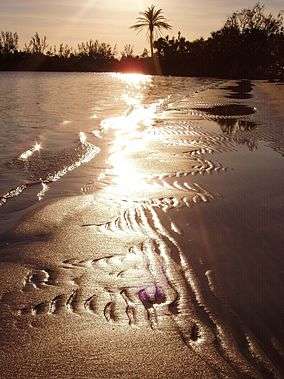Hobe Sound National Wildlife Refuge
The Hobe Sound National Wildlife Refuge, a part of the United States National Wildlife Refuge System, is a refuge on Jupiter Island in Florida. Its official name as of 2019 is the Nathaniel P. Reed Hobe Sound National Wildlife Refuge.[1] Part of the refuge is inside the town of Jupiter Island, while the rest is in the unincorporated areas of Martin County. The 1,035-acre (4.19 km2) refuge was established in 1969, to protect the loggerhead and green sea turtles. It is administered as part of the Arthur R. Marshall Loxahatchee National Wildlife Refuge.[2]
| Hobe Sound National Wildlife Refuge | |
|---|---|
IUCN category V (protected landscape/seascape) | |
 the refuge at dawn | |
  | |
| Location | Martin County, Florida, United States |
| Nearest city | Jupiter Island, Florida |
| Coordinates | 27°2′26″N 80°6′49″W |
| Area | 1,035 acres (419 ha) |
| Established | 1969 |
| Governing body | US Fish & Wildlife Service |
| Website | Hobe Sound National Wildlife Refuge |
Within the refuge is the 173-acre (0.70 km2) Reed Wilderness Seashore Sanctuary, designated a National Natural Landmark on November 1967.[2][3]
Beach erosion
According to the Florida Department of Environmental Protection, a significant amount of coastal erosion in Florida is directly attributable to the construction and maintenance of navigation inlets.[4]
In July 2013, approximately 200,000 cubic yards (150,000 m3) of beach-quality material was dredged from the St. Lucie Inlet Federal channel and impoundment basin and placed on the downdrift beaches of Jupiter Island in the vicinity of the Hobe Sound National Wildlife Refuge, with funding provided to the U.S. Army Corps of Engineers from the U.S. Congress.[5]
U.S. Fish and Wildlife
Hobe Sound National Wildlife Refuge was established September 30, 1969. It is a coastal refuge bisected by the Indian River Lagoon into two separate tracts of land totaling over 1000 acres. The 735-acre (297 ha) Jupiter Island tract provides some of the most productive sea turtle nesting habitat in the United States, and the 300-acre (120 ha) sand pine scrub mainland tract is valued because more than 90 percent of this community type has been lost to development in Florida. Sand pine scrub habitat is restricted only to Florida and an adjacent county in Alabama.[6]
Hobe Sound Nature Center
The Hobe Sound Nature Center is a private non-profit nature center that cooperates with the U.S. Fish and Wildlife Service to conduct environmental education and awareness programs about the Hobe Sound National Wildlife Refuge. The center was founded in 1973 by and continues to receive major support from the Jupiter Island Garden Club.
References
- "An Act To redesignate Hobe Sound National Wildlife Refuge as the Nathaniel P. Reed Hobe Sound National Wildlife Refuge, and for other purposes". Congress.gov. Retrieved 23 November 2019.
- Hobe Sound National Wildlife Refuge
- Reed Wilderness Seashore Sanctuary - National Natural Landmark
- "Florida Department of Environmental Protection - Why Restore Eroded Beaches?".
- "U.S. Army Corps of Engineers - FACT SHEET St. Lucie Inlet, F L (O&M) Operation and Maintenance Congressional District: 18" (PDF).
- "U.S. Fish and Wildlife".
External links
| Wikimedia Commons has media related to Hobe Sound National Wildlife Refuge. |
- Nathaniel P. Reed Hobe Sound National Wildlife Refuge - official site
- HSNWR Beach Webcam
- Hobe Sound Nature Center